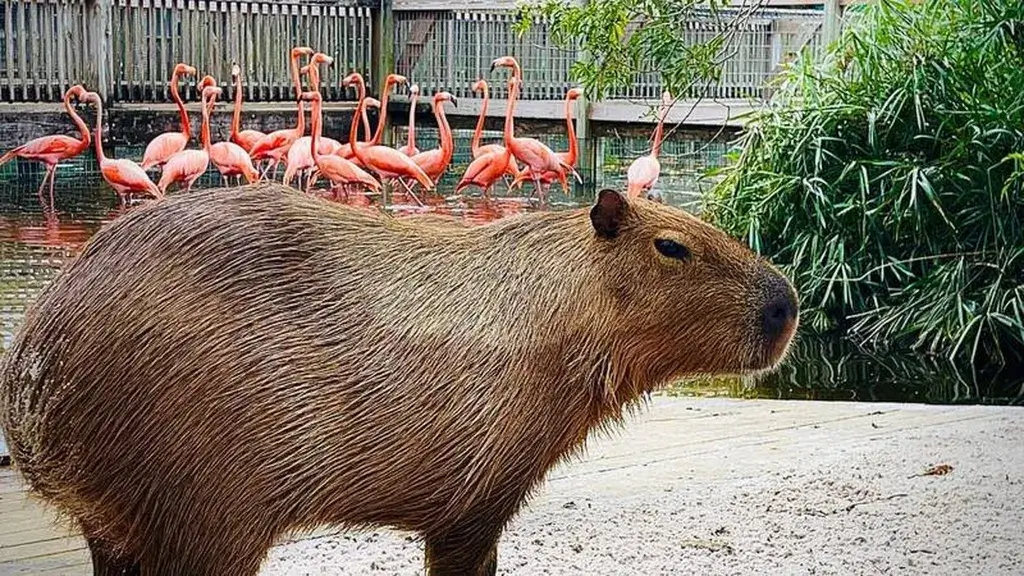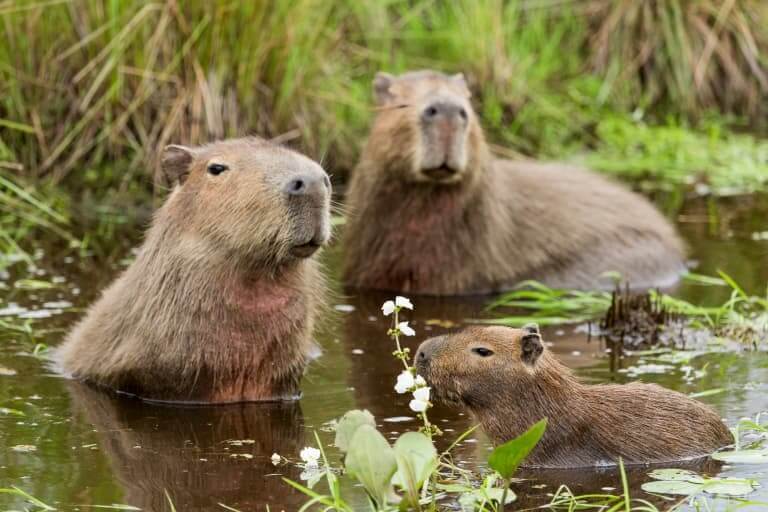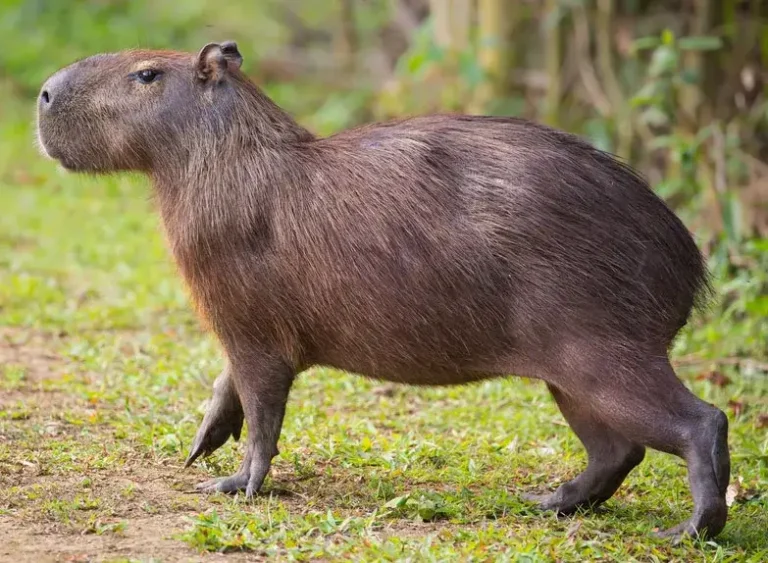The Sociable Side of Capybaras: Are They Truly Friendly Creatures?
Imagine a serene scene by the water’s edge: a group of capybaras lounging, with various animals like birds, turtles, and even monkeys, sharing their space, perhaps even hitching a ride on their backs. This unique camaraderie paints a vivid picture of the capybara’s friendly nature. But are these seemingly docile giants truly as friendly as they appear? Let’s delve deeper into the world of capybaras to uncover the truth.
Contents
- 1 Capybaras’ Social Behavior:
- 2 Capybara With Other Animals
- 3 Why do capybaras get along with every animal?
- 4 Key Traits of Capybara Behavior
- 5 Docility and Herbivorous Nature:
- 6 Examples of Friendly Interactions:
- 7 Capybaras and Their Interactions with Other Animals
- 8 Factors Contributing to Capybara Friendliness
- 9 Mutual Benefits:
- 10 Exceptions and Limitations:
- 11 Responsible Interaction:
Capybaras’ Social Behavior:
Capybaras, the most giant rodents on Earth, are inherently social animals, preferring the company of their kind in large herds. Their daily symphony of squeaks, chirps, and barks illustrates their constant communication within the group. These semi-aquatic creatures spend a significant portion of their lives in and around water, engaging in synchronized swimming and mating exclusively in aquatic environments.
Capybara With Other Animals
Capybaras are generally friendly towards other animals, but they can become prey for more giant cats and anacondas in South America. Weighing around 150 lbs, they are the most giant rodents and spend much time in water. They’re unbothered unless they sense danger, making them adaptable companions for various species.
Why do capybaras get along with every animal?
Capybaras get along with many animals due to their calm, social nature and low aggression levels. They thrive in groups and often form symbiotic relationships with birds and smaller animals. Fun fact: Capybaras even enjoy swimming with crocodiles!
Key Traits of Capybara Behavior
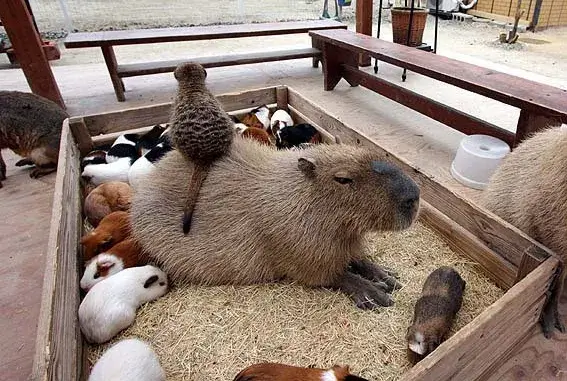
- Social Nature: Capybaras thrive in groups, demonstrating a strong preference for companionship. This inherent sociality extends beyond their species.
- Calm Demeanor: Known for their peaceful and relaxed temperament, capybaras rarely exhibit aggressive behavior, making them approachable to other animals.
- Mutual Grooming: Grooming is a significant part of capybara social life, and they often engage in this behavior with other species, fostering interspecies bonds.
Related: Are Capybaras Friendly Or Dangerous?
Docility and Herbivorous Nature:
Despite their large size, capybaras are gentle herbivores, posing little to no threat to other animals. Their peaceful demeanor and lack of aggression make them welcome among various species. Pictures and anecdotes abound of capybaras peacefully coexisting with creatures ranging from birds to monkeys, showcasing their tolerance and amiable disposition.
Examples of Friendly Interactions:
Capybaras serve as willing hosts for many animals, offering rides and acting as “cleaning stations” for birds seeking to remove parasites from their fur. Documented instances of capybaras mingling with crocodiles and alligators highlight their non-threatening nature and ability to form unlikely alliances across species lines.
Related: How Much Do Capybaras Weigh?
Capybaras and Their Interactions with Other Animals

Capybaras’ friendly nature leads to harmonious relationships with a variety of animals. Below are some notable examples:
Birds
Capybaras are often seen with birds perched on their backs. Birds such as egrets and small passerines benefit from this relationship by feeding on insects and parasites found on the capybaras’ fur. In contrast, the capybaras enjoy a form of grooming and pest control.
Turtles
Turtles frequently bask on capybaras in shared aquatic environments. This coexistence is peaceful and benefits both species as they share the warmth of the sun and the safety of numbers.
Monkeys
In some South American habitats, capybaras share their space with monkeys. These interactions are generally non-confrontational, as monkeys forage nearby while capybaras graze, showing a tolerance and indifference that typifies capybara behavior.
Domestic Animals
Capybaras have been known to get along well with domestic animals such as dogs, cats, and even livestock. Their docile nature makes them unlikely to provoke aggression, leading to friendly and curious interactions with household pets.
Related: Where Do Capybaras Live?
Factors Contributing to Capybara Friendliness
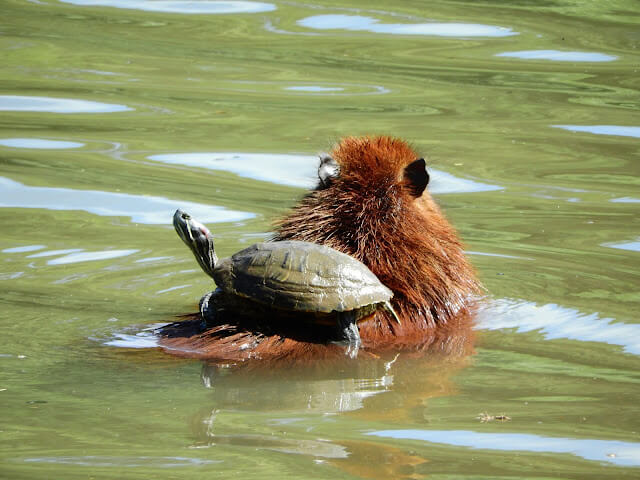
Several factors contribute to the capybara’s ability to coexist peacefully with other animals:
- Lack of Predatory Instincts: Capybaras are herbivores with no hunting instincts, making them non-threatening to other animals.
- Social Adaptability: Their evolutionary development in large social groups has made them adept at non-aggressive communication and conflict resolution.
- Environmental Factors: Sharing habitats with a variety of species in the wild has naturally selected capybaras that can coexist without conflict.
Mutual Benefits:
Other animals often benefit from associating with capybaras through protection, grooming, or scavenging for food scraps. The symbiotic relationship between capybaras and birds, where the latter helps rid the former of parasites, underscores the mutual advantages of these interspecies interactions.
Exceptions and Limitations:
While capybaras generally exhibit friendly behavior, there are exceptions. Territoriality, size discrepancies, and individual personalities can influence their interactions with other animals. Additionally, despite their friendly demeanor, capybaras are not exempt from the realities of predator-prey dynamics, necessitating caution in certain situations.
Responsible Interaction:
Responsible behavior is paramount when observing capybaras in the wild or considering them as pets. Understanding their social needs, space requirements, and potential impacts on local ecosystems is crucial for fostering positive relationships with these fascinating creatures while ensuring their well-being and conservation.
Related: What Does Capybaras Eat?
Conclusion:
In conclusion, capybaras’ reputation as friendly animals is well-deserved, supported by numerous instances of harmonious coexistence with various species. While exceptions exist, the consensus points to their docile nature and willingness to form bonds across species boundaries. By approaching interactions with respect and responsibility, we can continue to appreciate and learn from the unique friendships forged by these charismatic rodents.
Related: How Much Do Capybaras Weigh?
Frequently Asked Questions (FAQs) About Capybaras and Their Interactions with Other Animals:
1. Are capybaras dangerous to other animals?
A: Capybaras are generally not dangerous to other animals. They are herbivores and pose little threat to other species. They often coexist peacefully with various animals in their natural habitats.
2. Do capybaras have any predators?
A: Yes, capybaras do have predators. They are preyed upon by animals such as jaguars, caimans, anacondas, and humans. Despite this, capybaras’ large size and social behavior help deter many potential predators.
3. Can capybaras be aggressive towards other animals?
A: While capybaras are typically docile and non-aggressive, there may be instances of aggression, particularly when defending their territory or young. However, such behavior is rare and usually only occurs in specific circumstances.
4. How do other animals benefit from interacting with capybaras?
A: Other animals may benefit from associating with capybaras in various ways. This includes protection from predators, access to food scraps, and opportunities for grooming. Birds, in particular, often form symbiotic relationships with capybaras by removing parasites from their fur.
5. Are capybaras good pets for households with other animals?
A: Capybaras can potentially coexist with other animals in a household setting, but careful consideration should be given to their social needs and space requirements. Introducing a capybara to a home with existing pets should be done gradually and under supervision to ensure compatibility.
6. Do capybaras make good companions for humans?
A: Capybaras can form strong bonds with humans under the right circumstances. However, they require extensive care and attention, including access to outdoor space and water for swimming. Potential owners should thoroughly research capybara care and consider their long-term commitment before acquiring one as a pet.
7. Are capybaras legal to own as pets?
A: Regulations regarding the ownership of capybaras vary by location. In some areas, they may be classified as exotic pets and subject to specific licensing and permit requirements. Prospective owners should familiarize themselves with local laws and regulations before obtaining a capybara as a pet.
8. How can I observe capybaras interacting responsibly with other animals?
A: If observing capybaras in the wild, maintain a respectful distance and avoid disturbing their natural behavior. In captivity, visit reputable zoos or wildlife sanctuaries where animals are cared for ethically, and their welfare is prioritized. Remember to follow any staff-provided guidelines to ensure a safe and enjoyable experience for visitors and animals.
9. Are any risks associated with interacting with capybaras and other animals?
A: While capybaras are generally friendly and tolerant of other species, there are inherent risks associated with close contact, particularly in the wild. Always exercise caution and avoid approaching wild animals too closely. In captive settings, follow any safety protocols staff provide to minimize the risk of injury or harm to humans and animals.
- Golden Retriever Pros and Cons: What Every Pet Parent Should Know - 15 September 2025
- Cane Corso Dog Breed: Health, Care, and Lifespan - 14 September 2025
- Catahoula Leopard Dogs: Description, Temperament, Lifespan, & Facts - 21 July 2025

